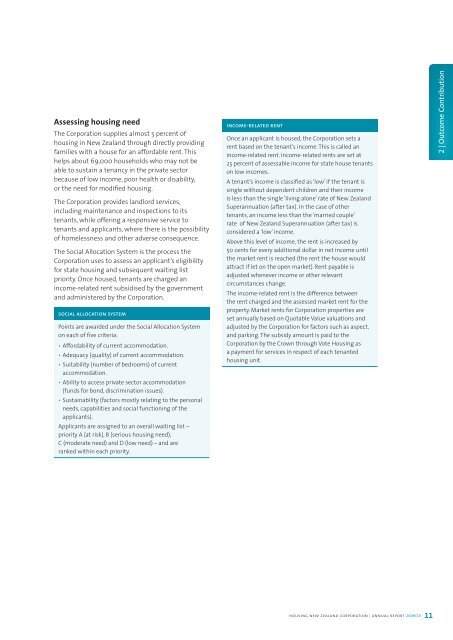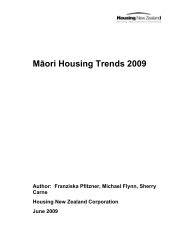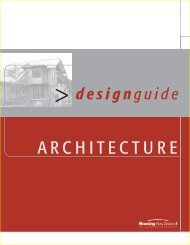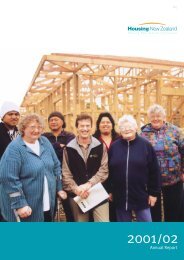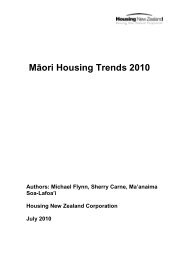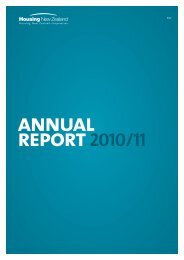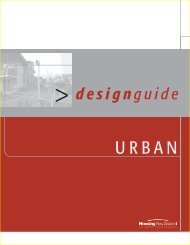Annual Report 2009/10 - Housing New Zealand
Annual Report 2009/10 - Housing New Zealand
Annual Report 2009/10 - Housing New Zealand
- No tags were found...
Create successful ePaper yourself
Turn your PDF publications into a flip-book with our unique Google optimized e-Paper software.
Assessing housing needThe Corporation supplies almost 5 percent ofhousing in <strong>New</strong> <strong>Zealand</strong> through directly providingfamilies with a house for an affordable rent. Thishelps about 69,000 households who may not beable to sustain a tenancy in the private sectorbecause of low income, poor health or disability,or the need for modified housing.The Corporation provides landlord services,including maintenance and inspections to itstenants, while offering a responsive service totenants and applicants, where there is the possibilityof homelessness and other adverse consequence.The Social Allocation System is the process theCorporation uses to assess an applicant’s eligibilityfor state housing and subsequent waiting listpriority. Once housed, tenants are charged anincome-related rent subsidised by the governmentand administered by the Corporation.social allocation systemPoints are awarded under the Social Allocation Systemon each of five criteria:• Affordability of current accommodation.• Adequacy (quality) of current accommodation.• Suitability (number of bedrooms) of currentaccommodation.• Ability to access private sector accommodation(funds for bond, discrimination issues).• Sustainability (factors mostly relating to the personalneeds, capabilities and social functioning of theapplicants).Applicants are assigned to an overall waiting list –priority A (at risk), B (serious housing need),C (moderate need) and D (low need) – and areranked within each priority.income-related rentOnce an applicant is housed, the Corporation sets arent based on the tenant’s income. This is called anincome-related rent. Income-related rents are set at25 percent of assessable income for state house tenantson low incomes.A tenant’s income is classified as ‘low’ if the tenant issingle without dependent children and their incomeis less than the single ‘living alone’ rate of <strong>New</strong> <strong>Zealand</strong>Superannuation (after tax). In the case of othertenants, an income less than the ‘married couple’rate of <strong>New</strong> <strong>Zealand</strong> Superannuation (after tax) isconsidered a ‘low’ income.Above this level of income, the rent is increased by50 cents for every additional dollar in net income untilthe market rent is reached (the rent the house wouldattract if let on the open market). Rent payable isadjusted whenever income or other relevantcircumstances change.The income-related rent is the difference betweenthe rent charged and the assessed market rent for theproperty. Market rents for Corporation properties areset annually based on Quotable Value valuations andadjusted by the Corporation for factors such as aspect,and parking. The subsidy amount is paid to theCorporation by the Crown through Vote <strong>Housing</strong> asa payment for services in respect of each tenantedhousing unit.2 | Outcome Contributionhousing new zealand corporation | annual report <strong>2009</strong>/<strong>10</strong> 11


